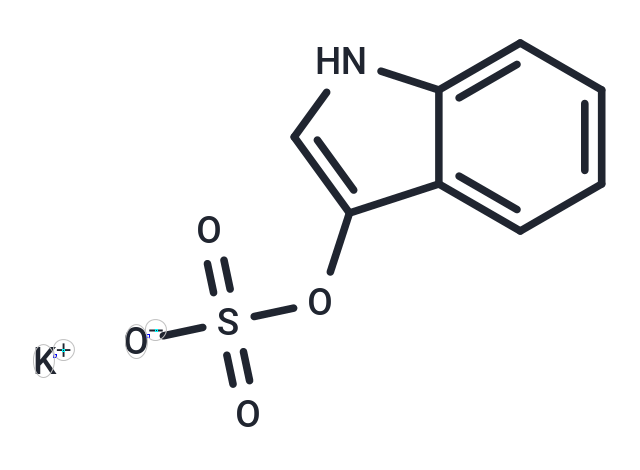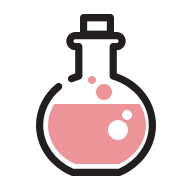- Remove All
 Your shopping cart is currently empty
Your shopping cart is currently empty
Shopping Cart
Potassium 1H-indol-3-yl sulfate
Catalog No. T4938Cas No. 2642-37-7
Alias Potassium 3-indoxyl sulfate, Indoxyl sulfate potassium salt
Potassium 1H-indol-3-yl sulfate (Potassium 3-indoxyl sulfate) is an agonist for the human Aryl Hydrocarbon Receptor (AhR), a key regulator of immune-inflammatory conditions. A metabolite of tryptophan derived from dietary protein, it is produced by intestinal bacteria and metabolized in the liver. In chronic kidney disease patients with impaired renal function, it accumulates in serum as a uremic toxin, inducing oxidative stress and accelerating disease progression. At 250 μM, it activates NF-Κb, promoting TGF-β1 and Smad3 expression in rat proximal tubular cells, which is associated with profibrotic activity.

Potassium 1H-indol-3-yl sulfate
Catalog No. T4938Alias Potassium 3-indoxyl sulfate, Indoxyl sulfate potassium saltCas No. 2642-37-7
Potassium 1H-indol-3-yl sulfate (Potassium 3-indoxyl sulfate) is an agonist for the human Aryl Hydrocarbon Receptor (AhR), a key regulator of immune-inflammatory conditions. A metabolite of tryptophan derived from dietary protein, it is produced by intestinal bacteria and metabolized in the liver. In chronic kidney disease patients with impaired renal function, it accumulates in serum as a uremic toxin, inducing oxidative stress and accelerating disease progression. At 250 μM, it activates NF-Κb, promoting TGF-β1 and Smad3 expression in rat proximal tubular cells, which is associated with profibrotic activity.
| Pack Size | Price | Availability | Quantity |
|---|---|---|---|
| 5 mg | $34 | In Stock | |
| 10 mg | $54 | In Stock | |
| 25 mg | $90 | In Stock | |
| 50 mg | $139 | In Stock | |
| 100 mg | $228 | In Stock | |
| 200 mg | $343 | In Stock |
Bulk & Custom
Add to Cart
Questions
View MoreSelect Batch
Purity:100%
Contact us for more batch information
All TargetMol products are for research purposes only and cannot be used for human consumption. We do not provide products or services to individuals. Please comply with the intended use and do not use TargetMol products for any other purpose.Product Introduction
Bioactivity
Chemical Properties
| Description | Potassium 1H-indol-3-yl sulfate (Potassium 3-indoxyl sulfate) is an agonist for the human Aryl Hydrocarbon Receptor (AhR), a key regulator of immune-inflammatory conditions. A metabolite of tryptophan derived from dietary protein, it is produced by intestinal bacteria and metabolized in the liver. In chronic kidney disease patients with impaired renal function, it accumulates in serum as a uremic toxin, inducing oxidative stress and accelerating disease progression. At 250 μM, it activates NF-Κb, promoting TGF-β1 and Smad3 expression in rat proximal tubular cells, which is associated with profibrotic activity. |
| Alias | Potassium 3-indoxyl sulfate, Indoxyl sulfate potassium salt |
| Molecular Weight | 251.3 |
| Formula | C8H6KNO4S |
| Cas No. | 2642-37-7 |
| Smiles | [K+].[O-]S(=O)(=O)Oc1c[nH]c2ccccc12 |
| Relative Density. | no data available |
Storage & Solubility Information
| Storage | store at low temperature | Pure form: -20°C for 3 years | In solvent: -80°C for 3 months | Shipping with blue ice. | |||||||||||||||||||||||||||||||||||
| Solubility Information | DMSO: 100 mg/mL (397.93 mM), Sonication is recommended. H2O: 50 mg/mL (198.97 mM), Sonication is recommended. | |||||||||||||||||||||||||||||||||||
Solution Preparation Table | ||||||||||||||||||||||||||||||||||||
H2O/DMSO
| ||||||||||||||||||||||||||||||||||||
Sci Citations
Calculator
In Vivo Formulation Calculator (Clear solution)
Please enter your animal experiment information in the following box and click Calculate to obtain the mother liquor preparation method and in vivo formula preparation method:
Mother liquor preparation method: 2 mg of drug dissolved in 50 μL DMSO (mother liquor concentration of 40 mg/mL), if you need to configure a concentration that exceeds the solubility of the product, please contact us first.
(mother liquor concentration of 40 mg/mL), if you need to configure a concentration that exceeds the solubility of the product, please contact us first.
Preparation method for in vivo formula: Take 50 μL DMSO main solution, add 300 μLPEG300
main solution, add 300 μLPEG300 mix well and clarify, then add 50 more μL Tween 80, mix well and clarify, then add 600 more μLddH2O
mix well and clarify, then add 50 more μL Tween 80, mix well and clarify, then add 600 more μLddH2O mix well and clarify
mix well and clarify
For Reference Only. Please develop an appropriate dissolution method based on your laboratory animals and route of administration.
Dose Conversion
You can also refer to dose conversion for different animals. More Dose Conversion
Tech Support
Please see Inhibitor Handling Instructions for more frequently ask questions. Topics include: how to prepare stock solutions, how to store products, and cautions on cell-based assays & animal experiments, etc
Keywords
Related Tags: buy Potassium 1H-indol-3-yl sulfate | purchase Potassium 1H-indol-3-yl sulfate | Potassium 1H-indol-3-yl sulfate cost | order Potassium 1H-indol-3-yl sulfate | Potassium 1H-indol-3-yl sulfate chemical structure | Potassium 1H-indol-3-yl sulfate formula | Potassium 1H-indol-3-yl sulfate molecular weight

Copyright © 2015-2025 TargetMol Chemicals Inc. All Rights Reserved.



